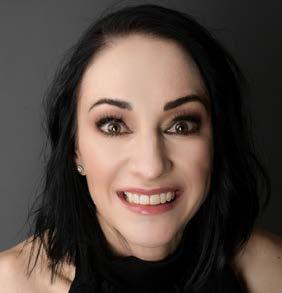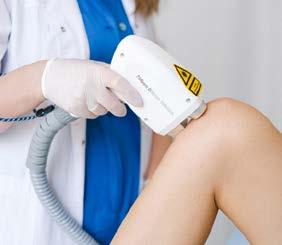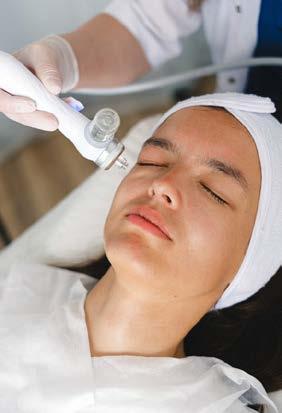
7 minute read
Aesthetic therapists reveal their top tips for practicing
An aesthetic practice is only as good as the services it offers as well as the practitioners who perform these services. KAREN ELLITHORNE poses questions to three top aesthetic therapists to discover their secrets to success

Advertisement
Sonette Donker Diana van Sittert Lourette Du Toit

The aesthetic therapists interviewed in this article are all qualified somatologists who currently either own their own businesses, or hold senior positions in the companies they work for.
These somatologists have managed to evolve and become some of the top performers in the aesthetics industry. Their success has been achieved through being passionate and by continually keeping themselves educated and abreast of the latest treatment trends.
The therapists are:
SONETTE DONKER
Clinic: Skin iD Position: Owner and Therapist
DIANA VAN SITTERT
Clinic: SkinPhD Head Office Position: Operational Manager + R&D
LOURETTE DU TOIT
Clinic: Dermology Position: Owner & Managing Director
How did you evolve from a skin care therapist to an aesthetic therapist?
Diana van Sittert: As a student in 1998, the industry was all about a cosmetic superficial beautifying approach and with the main aim of relaxation and sensory stimulation. For me this was simply not enough. I asked myself – why do we have to compromise on either results or ‘the feel-good factor’? Why can’t we have both? This led me on a path reading as much literature that was available, connecting with mentors like Professor Aubrey Parsons and other cosmeceutical giants. Being part of brands such as pHformula and Nimue gave me the exposure to travel internationally and have incredible conversations around new technologies and ingredients, etc.
Sonette Donker: I had the privilege of working with plastic surgeons and aesthetic product brands, which opened up the world of aesthetics for me.
Lourette du Toit: Moving from the spa and/ or beauty industry over to aesthetics can be very challenging for a therapist. I wanted to join the industry when I moved from the Kruger National Park to Johannesburg. After working for six years in the spa industry as spa manager and head therapist at a 5-star game lodge, I really wanted to grow into the medical side of our industry. After contacting a few doctors and being turned away as I had no experience, I finally joined a brand-new practice, Dermology, as practice manager/ therapist. In this role I grew in our beautiful and exciting industry, and finally became the owner of this same company. I found that people wanted experienced therapists. So, how do you become experienced if you cannot get a job in the industry? My vision is to employ young and aspiring therapists and grow them in our industry.

Photo by Anna Shvets from Pexels

Photo by Anna Shvets from Pexels
So, how do you become experienced if you cannot get a job in the industry? My vision is to employ young and aspiring therapists and grow them in our industry. – Lourette du Toit
What is your current favorite treatment modality or treatment protocol and why?
Diana van Sittert: By far my current favourite is combining product and technology to ensure optimal results, ensure the control of trauma / inflammation and skin supporting factors to assist with healing. So it would be as follows: Step 1: The correct combination acid peel with active ingredients left at a cellular level has shown that there is a better skin penetration response but also assistance from the active ingredients to ‘heal’ and consistently improve cellular functioning for weeks thereafter. Step 2: Needling with depth adjustment to ensure additional collagen stimulation. Step 3: After care that contains ionic colloidal silver to ensure that the inflammation we want remains controlled. This assists greatly in PIH (Post Inflammatory Hyperpigmentation) prevention.
Sonette Donker: I love chemical peels. They are quick and easy to perform and I love the results achieved.
Lourette du Toit: My favorite treatment protocol is combination therapy. I believe in putting together that perfect recipe for each individual patient, to ensure that they get the best opportunity to work towards their future skin. Furthermore, I also strongly believe in looking outside of the box when putting together that recipe. I am a laser therapist and light resurfacing lasers and gold standard light devices are my niche. Combining these procedures just takes your treatment to a whole new level and creates long term results for patients.
What would you say are the ideal qualities of an aesthetic therapist?
Diana van Sittert: One quote summarises this answer: ‘If you cannot explain it simply, you don’t understand it well enough’. Continuous learning is necessary, as well as questioning brand training information – do they just want to sell their product OR does it make sense? Consultation, consultation, consultation. You cannot offer your clients optimal results without ascertaining what their main skin concerns are, their goals, their expectations, etc. Every client MUST have a treatment and home care plan for at least six months, to be reviewed or amended every three months. Following up and consistent
communication is key. Educate the client with visual tools so that she/ he understands what the process of skin concern improvement involves.
Sonette Donker: You need to have an extensive knowledge of the skin and the products you work with. Having this knowledge allows you to customise the treatments to the client’s individual needs. You will also be able to treat the skin better if there are any complications with the treatment.
Lourette du Toit: A good aesthetic therapist never wants to stop learning; one who wants to continuously grow her/ his knowledge and welcomes critique. Empathy is crucial in our industry. We need to be able to identify and understand our patient’s emotions. The fact that we often work on patients’ faces with powerful equipment and ingredients requires lots of hand holding post procedure.
What do you look for when making a decision about taking on a new professional brand?
Diana van Sittert: Proven clinical data; independent testing; ingredient quality and supplier; cost versus result; offering options for all skin concerns; and marketing support.
Sonette Donker: Solid clinical data and high profit margins.
Lourette du Toit: I believe there are many successful brands with high quality ingredients available. As such, I look at the standard aspects of a skincare brand, such as quality of ingredients. I check their facts and of course try the product on my own skin, or someone whose skin is indicated, for monitoring purposes as the proof is in the pudding, right? Apart from this, I also look at the support offered from the suppliers, such as marketing, consignment and samples.
Continuous learning is necessary for a therapist, as well as questioning brand training information – do they just want to sell their product OR does it make sense? – Diana van Sittert

Photo by Anna Shvets from Pexels
What are your favorite active ingredients and why?
Diana van Sittert: There are so many! How do I choose? Ingredients that I am currently researching and impressed with are CBD (Cannabidiol) due to the incredible anti-inflammatory action in topical application, and azelaic acid, because of the indirect hormonal effect it can have on improving teenage and adult acne overall.
Sonette Donker: TCA (Trichloroacetic Acid) – the skin afterwards just looks amazing. Vitamin K is great to soothe and speed up the skin healing after peels. And of course, retinol is the ultimate in anti-ageing.
Lourette du Toit: It’s difficult to choose only one! When I start talking ingredients, I get completely carried away. One of my absolutely top ingredients is retinol, it’s a must in most skincare regimes. Retinol comes in a variety of forms and also offers multiple benefits to the skin, such as an increase in cellular turnover, which will lead to a more even skin tone, smoother texture and of course, less fine lines. Niacinimide, an active form of Vitamin B3, is next on my list as an all rounder ingredient for everyone. I am a firm believer that we need to focus on healthy skin rather than perfect skin. If your skin barrier is not intact, you will not get the best benefits from your procedures and other products. In fact, it can even go the opposite direction. Niacinimide will not only strengthen the skin barrier but also offers many other benefits, such as regulating sebum production and inhibiting melanosome transfer from melanocyte to keratinocyte. Therefore, niacinamide is not only a friend to our skin barrier, but also useful for fighting acne and hyperpigmentation.
A qualified aesthetician, Karen Ellithorne has been actively involved in the skincare industry since 1992, working as a lecturer and therapist, as well as successfully importing and distributing various products throughout South Africa. karen@spaandsalonsolutions.co.za





